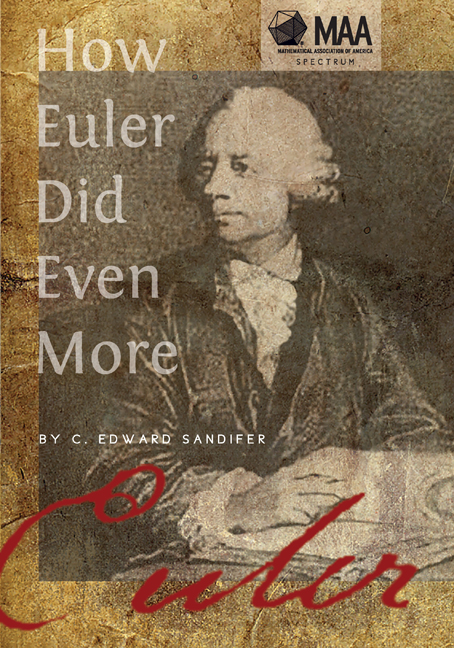Book contents
- Frontmatter
- Contents
- Preface
- Part I Geometry
- Part II Number Theory
- Part III Combinatorics
- Part IV Analysis
- 12 e, π and i: Why is “Euler” in the Euler Identity (August 2007)
- 13 Multi-zeta Functions (January 2008)
- 14 Sums of Powers (June 2009)
- 15 A Theorem of Newton (April 2008)
- 16 Estimating π (February 2009)
- 17 Nearly a Cosine Series (May 2009)
- 18 A Series of Trigonometric Powers (June 2008)
- 19 Gamma the Function (September 2007)
- 20 Gamma the Constant (October 2007)
- 21 Partial Fractions (June 2007)
- 22 Inexplicable Functions (November 2007)
- 23 A False Logarithm Series (December 2007)
- 24 Introduction to Complex Variables (May 2007)
- 25 The Moon and the Differential (October 2009—A Guest Column by Rob Bradley)
- Part V Applied Mathematics
- Part VI Euleriana
- About the Author
12 - e, π and i: Why is “Euler” in the Euler Identity (August 2007)
from Part IV - Analysis
- Frontmatter
- Contents
- Preface
- Part I Geometry
- Part II Number Theory
- Part III Combinatorics
- Part IV Analysis
- 12 e, π and i: Why is “Euler” in the Euler Identity (August 2007)
- 13 Multi-zeta Functions (January 2008)
- 14 Sums of Powers (June 2009)
- 15 A Theorem of Newton (April 2008)
- 16 Estimating π (February 2009)
- 17 Nearly a Cosine Series (May 2009)
- 18 A Series of Trigonometric Powers (June 2008)
- 19 Gamma the Function (September 2007)
- 20 Gamma the Constant (October 2007)
- 21 Partial Fractions (June 2007)
- 22 Inexplicable Functions (November 2007)
- 23 A False Logarithm Series (December 2007)
- 24 Introduction to Complex Variables (May 2007)
- 25 The Moon and the Differential (October 2009—A Guest Column by Rob Bradley)
- Part V Applied Mathematics
- Part VI Euleriana
- About the Author
Summary
One of the most famous formulas in mathematics, indeed in all of science is commonly written in two different ways:
eπi = −1 or eπi + 1 = 0.
Moreover, it is variously known as the Euler identity (the name we will use in this column), the Euler formula or the Euler equation. Whatever its name or form, it consistently appears at or near the top of lists of people's “favorite” results. It finished first in a 1988 survey by David Wells for Mathematical Intelligencer of “most beautiful theorems.” It finished second in a 2004 survey by the editors of Physics World to select the “greatest equations” and it was third in a 2007 survey of participants in an MAA Short Course of “Euler's greatest theorems.”
Whether people call it a formula, an equation or an identity, and regardless of which form they use, almost everyone credits the result to Euler. But it is not entirely clear why people give him credit for this result, because he never wrote it down in anything remotely like this form, because he wasn't the first one to know the fact behind the formula, and because he himself credited that fact to hismentor, Johann Bernoulli. In this column we will look at the origins of the Euler identity, see what Euler contributed, and consider whether it is correctly named.
Phase 1: 1702 to 1729
There are two formulas that are closely related to the Euler identity. The first we will call the “Euler formula”:
eiθ = cosθ + i sin θ
The Euler identity is an easy consequence of the Euler formula, taking θ = π. The second closely related formula is DeMoivre's formula:
(cos θ + i sin θ)n = cos nθ + i sin θ.
This, too, is an easy consequence of the Euler formula, since
(cos θ + i sin θ)n = (eiθ)n = einθ = cos nθ + i sin nθ.
- Type
- Chapter
- Information
- How Euler Did Even More , pp. 83 - 87Publisher: Mathematical Association of AmericaPrint publication year: 2014

